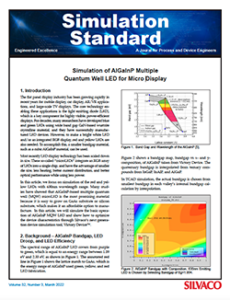Simulation of AlGaInP Multiple Quantum Well LED for Micro Display
Introduction
The flat panel display industry has been growing rapidly in recent years for mobile display, car display, AR/VR applications, and large-scale TV displays. The core technology enabling these applications is the light emitting diode (LED), which is a key component for highly visible, power-efficient displays. For decades, many researchers have developed blue and green LEDs using wide band gap GaN-based wurtzite crystalline material, and they have successfully manufactured LED devices. However, to make a bright white LED and/or an integrated RGB display, red and yellow LEDs are also needed. To accomplish this, a smaller bandgap material, such as a cubic AlGaInP material, can be used.
Most recently LED display technology has been scaled down in size. These so-called “microLEDs” integrate an RGB array of LEDs into a single chip, and have the advantage of smaller die size, less heating, better current distribution, and better optical performance while using less power.
In this article, we focus on simulation of the red and yellow LEDs with 630nm wavelength range. Many studies have showed that AlGaInP-based multiple quantum well (MQW) microLED is the most promising material because it is easy to grow on GaAs substrate or silicon substrate, which makes it an affordable option to manufacture. In this article, we will simulate the basic operation of AlGaInP MQW LED and show how to optimize the device characteristics through Silvaco’s next generation device simulation tool, Victory DeviceTM.



